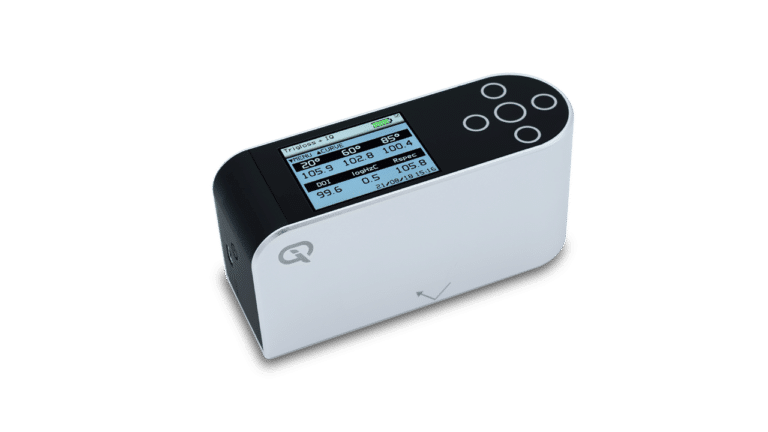What is gloss and how is it measured?

Reflectance values for low gloss matt surfaces are too low to be able to determine any differences when observed visually – so predominantly gloss is of importance.
However, as the reflectance value increases towards high gloss the effects of surface texture become more significant, therefore, as defined above, for these surfaces the use of the 20-degree angle is preferred for greater accuracy and resolution.
Gloss is the visual sensation associated with the perceived brightness of direct light reflected from a surface. Surfaces with high reflectance are determined as glossy; less reflective surfaces are semi-gloss or matt.
Gloss meters quantify this effect by measuring the specular light reflection from a surface at an equal but opposite angle of illumination at defined angles.
Gloss Unit
The Gloss Unit (GU) is defined in international standards including ISO 2813 and ASTM D523. It is determined by the amount of reflected light from a glass standard of known refractive index.
The measurement angles most commonly used for gloss are 20°, 60° and 85°.
The most appropriate angle should be selected dependent on the glossiness of the sample surface.
Using the correct measurement geometry increases resolution and improves the correlation of results with human perception of quality.
How to determine the best angle
To determine the correct measurement angle the surface should be assessed with the 60° geometry-
- Matt surfaces which measure below 10 GU @ 60°should be re-measured with the 85° angle.
- High gloss surfaces which measure above 70 GU @ 60° should be assessed using the 20° angle.
- The 60 degree angle is best suited to mid gloss measurement of samples between 10-70 GU.

Law of Reflection

Law of reflection is the direction of incoming light and the direction of outgoing light reflected make the same angle with respect to the surface.
The standard method for measuring gloss using a gloss meter at 20° requires an acceptance angle of ± 0.9° around the specular angle of 20°.
This narrow angular measurement range of reflected light does not allow the sensor in a gloss meter to detect the texture on a surface as the structures within the texture cause the reflected light to be deflected at a greater angle.
Measuring Gloss with the Rhopoint IQ
The Rhopoint IQ is different to a gloss meter as it uses a linear diode array (LDA) at 20° to measure the distribution of reflected light between 12.75° – 27.25°.
Conventional glossmeter optics are used at 60° & 85° and these fully comply with international gloss standards such as ISO 2813 and ASTM 523.
The instrument does not have physical receiver apertures like a conventional gloss meter; the 20° gloss value is obtained by measuring with the elements of the linear array that correspond to the angles specified in the standards.
This feature allows the instrument to quantify the effects of texture on a surface that can be classified as either orange peel or haze according to their size.
Related products

Concrete Clarity Meter (CCM)
- Industry standard Concrete Clarity Meter
- Measures Gloss, Haze and DOI of polished concrete
- 20/60˚ Glossmeter for high gloss finishes
- Compatible with concrete polishing standards

Rhopoint IQ 20/60 Gloss Haze DOI Meter
- 20/60 gloss meter for matt to mirror finishes
- Haze and DOI measurement to ASTM E430
- To ensure accurate and reliable results, the Rhopoint IQ 20/60 Gloss Haze DOI Meter is supplied with standards calibrated and certified according to ISO 17025 UKAS
- Why should I buy an IQ and not a standard gloss meter?

Rhopoint IQ 20/60/85 Gloss Haze DOI Meter
- 20/60/85° gloss meter for matt to mirror finishes
- Haze and DOI measurement to ASTM E430
- To ensure accurate and reliable results, the Rhopoint IQ 20/60/85 Gloss Haze DOI Meter is supplied with standards calibrated and certified according to ISO 17025 UKAS
- Why should I buy an IQ and not a standard glossmeter?
